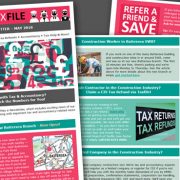New 30-Day Rules for Capital Gains on Residential Property

New rules have now come into force in relation to capital gains made on disposals of UK residential property*. Several key actions are now required if a taxable capital gain has arisen, including some that now need to be made fast:
- Taxpayers need to report the property’s disposal within 30 days of the actual disposal;
- They will need to pay the estimated Capital Gains Tax (‘CGT’) to HMRC within 30 days of the disposal.
- Those who fill in and submit a Self-Assessment tax return will also need to include details of the disposal on their return.
Who Do the New CGT Rules Apply To?
The new rules apply whether you’re an individual, joint property owner, trustee, partner in a partnership or LLP, or a personal representative.
What Counts as a Residential Property Disposal?
The new rules apply to all UK residential property that was disposed of (taken as the date of the exchange of contracts) since 6 April 2020 inclusive, where a capital gain was made that will require payment of CGT.
To fall within the rules, a UK residential property must be one that:
- is suitable for use as a dwelling, or;
- is being built or adapted for use as a dwelling.
It can be one in which the the owner has never lived or has lived for only part of the period they owned it. It can also be a rental property or a holiday home.
Where a property has been used for mixed purposes, only the capital gain that’s equivalent to the portion used for residential dwelling purposes is subject to the new 30-day rules.
Are There Any Exceptions?
Yes, there are several possible scenarios where the new rules do not apply. Reporting or CGT payment is NOT required within 30 days in any of the following scenarios:
- where a residential property is transferred between spouses or civil partners without a gain or loss;
- where a residential property is disposed of at a loss;
- for disposal of a person’s main residence, so long as they have occupied it all the time they’ve owned it;
- when the property is disposed of via a commercial lease, provided for no premium to an unconnected individual;
- when the property is disposed of by a charity;
- when a property that was part of a pension scheme investment is disposed of;
- when the property disposal is chargeable to income tax.
Certain exemptions also apply to disposal of a residential property. These include the ‘annual exemption’ (see ‘Calculating the CGT’ section below) and ‘main residence relief’.
The Reporting Procedure
A new digital service has been developed by HMRC for reporting of any capital gains from disposals that fall under the new rules. All such reports need to be submitted through this new digital service.
Individuals and trustees will need a Capital Gains Tax on UK Property Account on the HMRC website. Options include using the service directly or, alternatively, authorising a tax adviser like Taxfile to report through the system on your behalf.
A payment reference number will be issued by HMRC once the 30-day return has been submitted to the system. This can be used as a payment reference for the estimated Capital Gains Tax that needs to be paid within the same 30-day period.
The 30-Day Reporting & Payment Deadline
Both reporting of — and CGT payment on account for — disposals of applicable residential properties need to take place within 30 days of the legal completion date (not exchange of contracts) of the property’s disposal.
If Your CGT Payment is Late
If you report your applicable property disposals late, or pay the resulting CGT late, HMRC will apply penalties (fines) and charge interest on the unpaid tax. An exception, however, would be where reporting was done already, on time, via a self-assessment return.
Calculating the CGT to Pay on Account
Part of filing the digital report involves submission of a tax computation. This is used to work out the estimated CGT that will need to be paid on account to HMRC within the 30 days following disposal of the residential property in question.
Certain amounts can be used to offset any CGT that’s due. These include:
- The taxpayer’s Annual Exemption, which is an allowance against capital gains (of £12,300 for the financial year 2021-22);
- Applicable capital losses incurred before disposal of the residential property, including any brought forwards from earlier financial years.
As mentioned above, a taxpayer’s self-assessment tax return can also be used to report on applicable disposals of residential property. A computation therefore also needs to be made as part of such a return, in order to compute any CGT due under the new rules. As above, prior years’ losses can also be offset against the CGT due and indeed a self-assessment tax return submission can be used to adjust any earlier CGT estimate submitted to HMRC. If the final amount of CGT ultimately ends up being more than the estimated amount previously submitted, interest will be charged by HMRC on the shortfall.
We’re Tax Advisers & Accountants in South London, the South East and South West of England
If you have any questions, please telephone 020 8761 8000 or contact us here. We are accountants and tax advisers with offices in Tulse Hill, Dulwich and Devon/Cornwall. We help sole traders, the self-employed, limited companies, directors and individuals with anything to do with tax and accountancy.
*The new rules apply to UK residential property, not non-residential properties or properties outside the UK.
This post was brought to you by Ewelina at Taxfile & edited by Mark.










